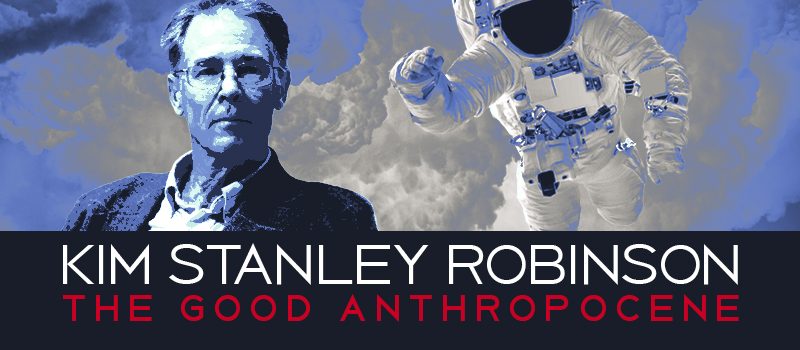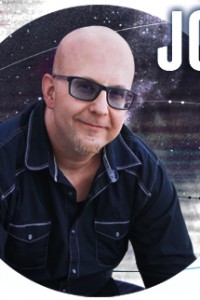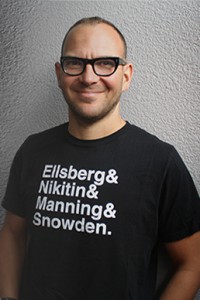Kim Stanley Robinson: The Good Anthropocene

KIM STANLEY ROBINSON was born March 23, 1952 in Waukegan IL, and grew up in Orange County CA. He earned a BA in literature from UC San Diego in 1974, a master’s in English from Boston University in 1975, and a PhD in literature from UC San Diego in 1982. He went to Clarion in 1975. His doctoral thesis was revised and published as The Novels of Philip K. Dick (1984). He lived in Switzerland and Washington DC in the ’80s, and has spent time doing research in Nepal, Antarctica, Italy, and China, among other locations.
His ongoing interest in utopian and ecological issues is evident even in his earliest work. His first novel, The Wild Shore (1984), began his Orange Country trilogy, was nominated for a Nebula Award, and won the Locus Award for Best First Novel. The Gold Coast (1988) and Pacific Edge (1990) followed, with the latter winning the John W. Campbell Memorial Award. Other early novels include Icehenge (1984) and The Memory of Whiteness (1985). Fantasy works include mosaic novel Escape from Kathmandu (1989) and surreal fantasy novella A Short Sharp Shock (1990), winner of a Locus Award.
Robinson is still perhaps best known for his Mars trilogy about terraforming Mars: Nebula winner Red Mars (1992), and Hugo and Locus Award winners Green Mars (1993) and Blue Mars (1996). A collection of related material, The Martians (1999), also won the Locus Award. Near-future ecological thriller Antarctica was the result of a National Science Foundation grant that sent Robinson to Antarctica as writer-in-residence. Locus Award winner The Years of Rice and Salt (2002) is a major alternate history about the development of science. His latest novel, Red Moon (2018), is about a Chinese lunar colony.
Robinson lives in Davis CA with his wife of more than 35 years, environmental chemist Lisa Nowell, and their two sons.
Excerpts from the interview:
“New York 2140 is not apocalyptic, it’s catastrophic. The difference is that apocalypse means the end of everything, or at least zombies in the streets, but really just extinction. That’s not what’s going to happen with climate change, at least not at first. The thing about climate change is it’s usually pretty slow. While it will include some quick catastrophes that just slap you in the face, like a big hurricane or fire or flood, it’s more often slow, like the five-year drought we had in California. There’s no one day when you have a freakout and, in this case, at no point did we turn the taps on only to have no water come out – that would have caused the freakout. That would have been the moment to write about, if you were going to write that story. But by and large climate change is a creeping process, where you have to pay attention to small things to tell the story, if you can at all. In New York 2140 it’s gone beyond small. There’s a sea level rise of 50 feet above what we have now – that’s insanely high, and would feel apocalyptic – but on the other hand, if you’re 70 feet above sea level, then it’s somebody else’s problem. If you’re in finance, then you try to find a way to hedge against it, to make money from it. What I wanted to show in New York 2140 is that life will go on after a catastrophe, and how weird it will be when vast neighborhoods of Manhattan become like Venice, with its streets now canals. I wanted to write about people who are born after the catastrophe and consider it normal.
“I went to Venice to see how the city works when the streets are canals. And I went to New York often, including to places tourists don’t usually go, like the Cloisters, at the very north end of Manhattan Island – that’s a hill that’s 240 feet above sea level. In a Venetian New York, that would become incredibly valuable real estate. It might be a place for gigantic new skyscrapers. I also went to Hell Gate and Coney Island, places that would be drowned, and to other sections of the Bronx and Brooklyn, checking out what they might be like if they were submerged. Then also, the old Met Life Tower on Madison Square is an architectural imitation of the Campanile in Venice, but about ten times as big. It’s a nice visual joke – you’ve got a Venetian building in New York already, so that was clearly where I needed my characters to live. That building is a hotel now, so I took a room for a night there and introduced myself to the customer relations person, a very nice young woman who showed me around right to the very top of the cupola tower, where guests aren’t usually allowed to go. There’s a tiny spiral staircase going up into a little viewing place. We also went all the way down into the lowest basements. She showed me almost everything in that building, and it kind of became a character in my story.
“All in all, the research for New York 2140 was about as much fun as I’ve ever had as a researcher, because I could actually visit it and speak the language. And I had a New York friend who showed me things that I wouldn’t have known about otherwise. I kind of fell in love with New York, in a way that now strikes me as a little crazy. It was a function of writing the book. Now it’s mostly like any other big city to me. The excitement of it has receded, but I still like being there. It’s one of my favorite cities.
“The subway system in New York is such a complicated tangle of overlapping old systems, and rather poor signage, that I used to be scared of it. Since most of publishing is in Midtown and I was mostly there for publishing business, I would just run from one meeting to another. Nobody cares if you’re running on the sidewalks in New York. Nobody cares no matter what you’re doing. I would run from meeting to meeting and never go on the subway, because every time I did I would get lost. But when I was researching this book I began to use the subway more. I’m still really bad at it. Sometimes I’ll make three or four mistakes on a single ride, but I’ve learned these mistakes aren’t fatal. You can still get where you’re going eventually.
“One difference between New York and London for me is that in London I trust the Tube. It has better signage, so all you have to do is pay attention and you will never go wrong. The best subway system I’ve ever seen is in Hong Kong. It would be hard to make a mistake there. It has all these electric signs that change, with colored lights blinking to tell you where to get on or off – it’s astonishing.
“Red Moon is about the Chinese colonizing the moon, and so it’s almost about right now – it’s set 30 years in the future, in 2047, when Hong Kong is supposed to revert to full Beijing control. The only big advance in my book, aside from the moon settlements, is the introduction of a quantum computer with a few thousand qubits stabilized. Whether that will mean amazing things is an open question, but it’s interesting to contemplate the possibilities.
“The Bay Area includes some people who are really interested in the moon, and they helped me with my book. In the first scene there’s a landing on the moon where their shuttle touches down while going something like 8,000 miles an hour – this is like a launch rail take-off, but in reverse. That was their idea. I never would have thought of that, because you have to hit the rail with just a couple centimeters tolerance for error. They told me that in a vacuum that wouldn’t be hard, and I thought, ‘Whoa. That would be one scary landing.’ It made for a fun way to start.
“I also did some research for this book in Antarctica, but really Antarctica is far more hospitable than the moon. The thing that’s similar is the way the scientific stations will work. If you want an analogy for what a moon base will be like, think South Pole station. Don’t think Plymouth Rock or Jamestown, that’s wrong – hugely wrong. The South Pole’s base is as close to a space station as we have on Earth. The International Space Station is another good analogy. It’s going to be awkward and dangerous, and you’ll always be indoors, except for occasional spacesuit ventures onto the surface. One thing I got out of my Antarctic trips was the feeling of what it would be like to be indoors in a very inhospitable place with a small group of scientists, and trips outdoors that were like EVAs.”
Interview design by Stephen H. Segal. Photo by Gage Skidmore.
Read the full interview in the December 2018 issue of Locus.
 While you are here, please take a moment to support Locus with a one-time or recurring donation. We rely on reader donations to keep the magazine and site going, and would like to keep the site paywall free, but WE NEED YOUR FINANCIAL SUPPORT to continue quality coverage of the science fiction and fantasy field.
While you are here, please take a moment to support Locus with a one-time or recurring donation. We rely on reader donations to keep the magazine and site going, and would like to keep the site paywall free, but WE NEED YOUR FINANCIAL SUPPORT to continue quality coverage of the science fiction and fantasy field.









My thanks to Kim Stanl;ey Robinson!
His books are a refreshing read these days when the SF&F has sunk into postapocalipse, zombies and other kinds of distopia.